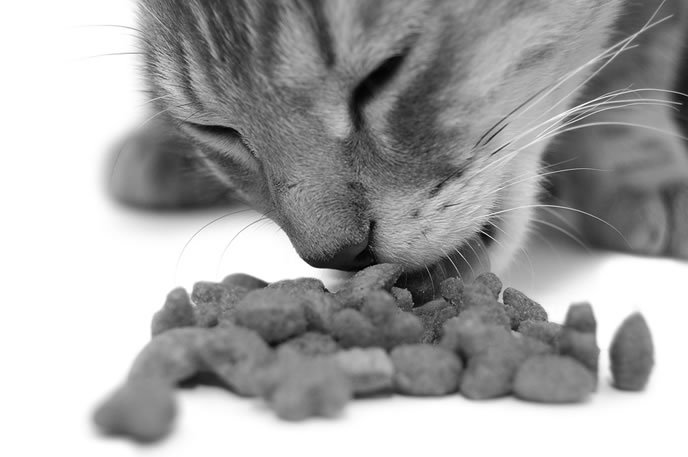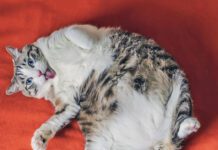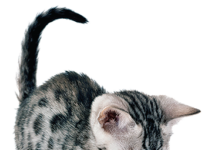By the end of the year, almost all pet food labels will provide information on calories per cup as part of the growing movement in veterinary medicine to counter pet obesity. The change has been several years in the making and would seem make it easier to feed our cats, but just like the challenge of deciphering the terms on labels — guaranteed analysis, ingredients vs. nutrients and total crude protein — determining the calories might not be simple.
Bigstock

Nutritionist Joseph Wakshlag, DVM, Ph.D., at Cornell University College of Veterinary Medicine offers one example: “The average indoor cat’s diet should be based on resting energy, similar to a human couch potato who watches TV most of the day. The problem is that pet food manufacturers’ recommendations are based on a theoretical activity level that doesn’t exist for most indoor cats.”
Many pet food companies already list calorie counts on their labels. Now almost all will do so, with some leeway for the change in labeling. The Association of American Feed Control Officials (AAFCO), a membership association that issued the calorie recommendation, has no regulatory powers, but most states follow its guidance on model regulations.
Dr. Wakshlag, president-elect of the American College of Veterinary Nutrition, explains the calorie recommendations and offers advice on feeding cats in general in this Q & A.
Q: Why did AAFCO institute the new recommendations?
A: Pressure from both consumers and veterinarians provided much of the incentive. Human foods have long had labeled calorie counts, and since many pet owners today consider their pets part of the family, they expect the same in their pets’ food.
Q: What will be the effects of the new recommendations?
A: Pet foods are already labeled with kcals/kilogram [a metric unit of energy in food, essentially the same as calories], so pet owners could theoretically translate that into an appropriate amount. But now the kcals per cup will also be visible.
One problem is that when cat owners measure out a “cup” of pet food, everyone’s cup is different. Some people use leftover Chinese food containers. Others use a sports drink cup. So the larger problem is educating people about what an actual cup of dry food consists of — which is eight ounces.
Q: What other issues will the new recommendations not address?
A: Pet foods can contain more calories than the label says. There’s a popular method of estimating calories called the 4, 4, 9 rule, which assumes that
one gram of protein contains 4 calories,
one gram of carbohydrate contains
4 calories, and one gram of fat contains
9 calories.
However, about 90 percent of pet food manufacturers have never done digestibility studies on their products, so the true caloric content of their foods is unknown.
Because they want to account for some foods that have lower digestibility, for years AAFCO has used another recommendation — the 3.5, 3.5, 8.5 rule — to calculate the calories that will be placed on the label. An owner might assume, for example, that they’re serving their pet 340 kcals, when they’re actually serving 375 or even 390 kcals. The owner, in providing the suggested amount of food, would actually be giving their pet 10 to 15 percent more calories than needed. This certainly will not help the obesity epidemic so prevalent in pets today.
Yet another problem is minimum fat. Pet food labels state only the minimum amount of protein and fat in their products. If there’s a minimum of 12 percent fat, the product might actually contain 15 percent fat. From a calorie perspective, fat is the densest part of a pet’s diet. The new labels will still not reflect the true calorie count if the fat count is much higher than what is labeled.
Finally, there’s the dietary fiber issue. Currently, only crude fiber levels are on pet food labels, but total fiber is a very important dietary component. A certain amount of fiber is good for you and good for your cat. Hopefully, total dietary fiber will eventually appear on pet food labels — perhaps in another 10 years or so!
Q: Why haven’t all pet food companies previously provided calorie counts?
A: In the mid-1990s, Procter & Gamble did a large study of caloric intake among dogs. As a result of their findings, they changed the feeding recommendations listed on their bags to a reduced amount. Unfortunately, some energetic, “high-octane” dogs lost weight on these reduced portions, and P&G reverted back to older, more inclusive feeding guidelines, which included cats.
Since this was a strong disincentive to other companies to help address the pet obesity problem, pet food companies were basically stuck with the higher calorie recommendations. AAFCO is now making an attempt to be more informative with these new global calorie recommendations, which will likely be followed by all states.
Q: How does a cat’s age figure in?
A: Adult cats pass through three stages: the adolescent/adult stage, the mature stage and the geriatric stage. From ages 6 through 12, most owners end up feeding their cats the same amount they fed during the cat’s adolescence, when they should be feeding their cats about 20 percent less due to their reduced activity level.
Q: What diseases might affect intake calorie increases or decreases?
A: Cats are prone to decreased kidney function as they age. Uremia (the buildup of toxins from protein metabolism) can make them feel sick, which further reduces their appetite. These cats often exhibit weight loss and have trouble meeting their calorie intake requirements. Special low-protein diets may allow cats to live longer but at the risk of them wasting away. It’s important to work with your cat’s veterinarian to meet both the protein and the calorie requirements in these challenging situations.
Cats are also prone to hyperthyroidism as they age. Symptoms include losing weight yet exhibiting constant hunger and begging for food. Veterinary care can alleviate these symptoms and help these cats maintain a healthy weight.
Q: Would a cat’s medications and supplements have an effect?
A: Soy proteins called isoflavones are sometimes used to lower blood cholesterol or decrease urinary incontinence in pets, though their efficacy is not proven. Some studies have linked the consumption of isoflavones with a temporary reduction in food intake.
Q: How often should pet owners feed their cat?
A: I’m a fan of feeding cats twice a day. We all enjoy sharing morning and evening mealtimes with our families. So when there are no medical problems, it seems appropriate to make mealtimes a family thing — regardless of whether or not your cat finishes his meal in two minutes!



